中级宏观经济学Abel_Chapter08
中级宏观经济学ppt课件第7、8章

经济秩序紊乱
通货膨胀会破坏正常的经济秩序,导致市场 信号失真。
影响国际竞争力
通货膨胀会降低本国货币的实际购买力,影 响国际竞争力。
治理失业与通货膨胀的政策措施及效果评估
治理失业的政策措施
促进经济增长,创造 更多的就业机会。
实施积极的就业政策, 如提供职业培训和就 业指导等。
治理失业与通货膨胀的政策措施及效果评估
失业人员无法为社会创 造财富,导致社会总产
出减少。
增加社会负担
失业人员需要社会提供 救济和保障,增加政府
财政负担。
影响社会稳定
长期失业会导致社会不 稳定因素增加,如犯罪
率上升等。
通货膨胀对社会经济的影响
物价上涨
通货膨胀导致货币贬值,物价普遍上涨,降 低消费者购买力。
社会财富再分配
通货膨胀会导致社会财富重新分配,通常不 利于固定收入者和储蓄者。
事业得到发展,从而推动社会进步。
03
经济增长创造就业机会
经济增长促进了企业扩张和产业升级,创造了更多的就业机会,降低了
失业率。
经济发展促进经济增长
经济发展优化资源配置
通过技术进步、产业升级和制度创新等手段,经济发展能够优化 资源配置,提高生产效率,从而促进经济增长。
经济发展提高国际竞争力
经济发展有助于提升国家的国际地位和综合国力,增强国际竞争力, 为经济增长创造更加有利的外部环境。
完善社会保障制度,保障失业人员的基本生活。 治理通货膨胀的政策措施
控制货币供应量,稳定物价。
治理失业与通货膨胀的政策措施及效果评估
01
调整财政政策,减少政府开支。
02
提高生产效率,降低成本。
效果评估
03
中级宏观经济学CHAP08

Technological progress causes E to grow at the rate g, and L grows at rate n so the number of workers L × E is growing at rate n + g. Now, the change in the capital stock per worker is: ∆k = i –(δ+n +g)k, where i is equal to s f(k). k sf(k) The Steady State (δ + n + g)k k Note: k = K/LE and y=Y/(L × Ε). So, y = f(k) is now different. Investment, Also, when the g term is added, k sf(k) gk is needed to provided capital to new “effective workers” created by technological progress. Capital per worker, k
Chapter Eight 10
The property of catch-up is called convergence. If there is not convergence, countries that start off poor are likely to remain poor. The Solow model makes predictions about when convergence should occur. According to the model, whether two economies will converge depends on why they differ in the first place (i.e., savings rates, population growth rates, and human capital accumulation).
最新课件中级宏观经济学
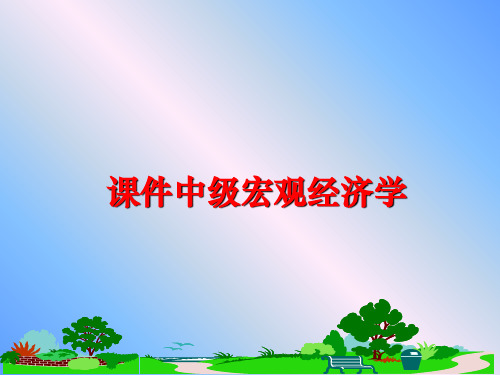
➢ 有效需求管理:财政政策、货币政策
2 宏观经济管理目标
▪ 四大目标(熨平经济波动、实现经济增长)
➢ 经济增长 ➢ 充分就业 ➢ 物价稳定 ➢ 国际收支平衡
▪ 本部分的主要介绍
➢ 通货膨胀 ➢ 失业
2.1 通货膨胀
▪ 通货膨胀的定义、度量(回忆)
▪ 通货膨胀的分类
➢ 依据预期来分类
0
M1,1929=100
1939 1938 1937 1936 1935 1934 1933 1932 1931 1930 1929
1.4 大危机鸟瞰— 货币银行
▪ 国际金融系统崩溃
▪ 投资暴跌
0
2
4
6
8
10
12
14
16
18
20
1.5 大危机鸟瞰——物价、投资
CPI,1929=100 i/gnp
➢ IS-LM模型和AS-AD模型
▪ 举例,政府支出带来的影响
价
利
IS
LM
率
格 水
平
i*
P
Y*
收入
A D
产量 Y
大作业
▪ 任选一题
➢结合所学,尝试回答下面的问题:目 前我国面临的主要宏观经济问题是什 么?如何表述、分析?如何治理?
➢ 为什么会发生大危机?经济是否具有内在的不稳定性? ➢ 是否可以避免?如何预防?
1.8 大危机的治理
▪ 大危机期间的治理
➢ 对内:平衡预算、美联储无作为 ➢ 对外:贸易保护、输出“紧缩”。 ➢ 结果:“盲人骑瞎马,夜半临深池”,危机更为严重
▪ 认识大危机
➢ 凯恩斯的解释:投资下降、有效需求不足 ➢ 弗里德曼的解释:美联储的无作为、货币存量下降
中级宏观经济学 主要内容

第二章:国民收入核算
收入法、支出法、产出法
链式加权的实际GDP
第三章长期中的封闭经济模型
第五章长期中的开放经济模型小型、大型
第七、八章经济增长
第九-十一章短期中的封闭经济凯恩斯交叉图
IS-LM AS-AD
长短期调整
第十二章短期中的开放经济
第十三章政策无效性命题
第十四章DAD-DAS模型
考试题型:
1.单选题(15分-20分,2-3分/题)
2.作图题(15-20分,2题)
要求:
3.计算、分析、作图题(60-70分)
要求:要有计算步骤和必要的文字说明,作图要以题目的计算结果为基础,
小数位数的保留按照题目要求,
计算结果可保留分数和根号等形式。
考试具体题型及分布确定后会及时发送到课程邮箱。
考试时间:16周周一7-8节
作图题练习:
作图分析政府购买增加在各模型中的效应,对变量有何影响?。
巴德 宏观经济学原理(英文版第8版) 学生课件Chapter 8 PowerPoint
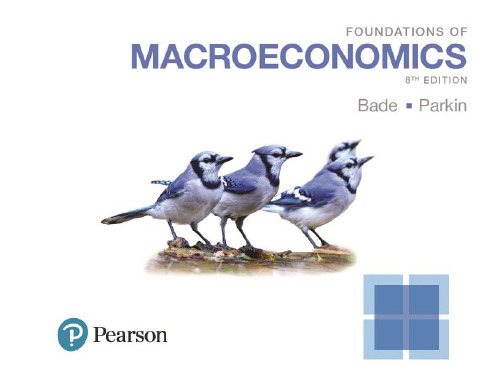
MACROECONOMIC APPROACHES AND PATHWAYS
Keynesian Macroeconomics
According to Keynesian macroeconomics, the market economy is inherently unstable and it requires active government intervention to achieve full employment and sustained economic growth. John Maynard Keynes, in his book “The General Theory of Employment, Interest, and Money,” began this school of thought. Keynes’ theory was that too little consumer spending and investment led to the Great Depression.
Copyright © 2018, 2015, 2013 Pearson Education, Inc. All Rights Reserved
MACROECONOMIC APPROACHES AND PATHWAYS
MACROECONOMIC APPROACHES AND PATHWAYS
Classical macroeconomics fell into disrepute during the 1930s, which was a decade of high unemployment and stagnant production throughout the world. Great Depression is a decade (the 1930s) of high unemployment and stagnant production throughout the world economy. Classical macroeconomics predicted that the Great Depression would end but gave no method for ending it more quickly.
亚伯《中级宏观经济学》 笔记和课后习题详解(宏观经济学概述)【圣才出品】
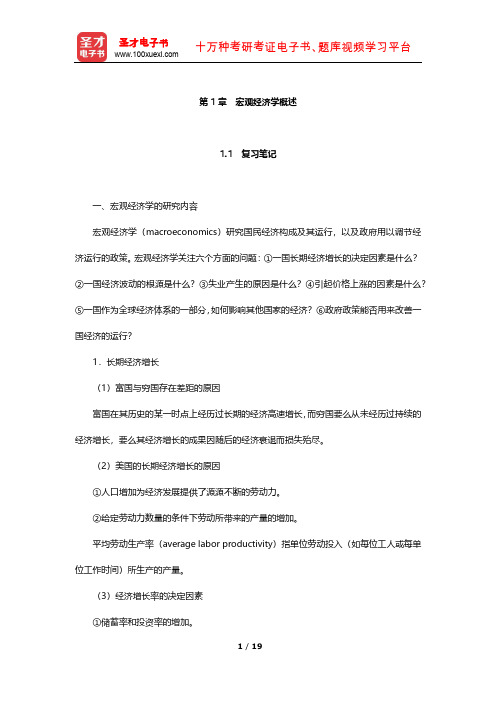
第1章宏观经济学概述1.1 复习笔记一、宏观经济学的研究内容宏观经济学(macroeconomics)研究国民经济构成及其运行,以及政府用以调节经济运行的政策。
宏观经济学关注六个方面的问题:①一国长期经济增长的决定因素是什么?②一国经济波动的根源是什么?③失业产生的原因是什么?④引起价格上涨的因素是什么?⑤一国作为全球经济体系的一部分,如何影响其他国家的经济?⑥政府政策能否用来改善一国经济的运行?1.长期经济增长(1)富国与穷国存在差距的原因富国在其历史的某一时点上经历过长期的经济高速增长,而穷国要么从未经历过持续的经济增长,要么其经济增长的成果因随后的经济衰退而损失殆尽。
(2)美国的长期经济增长的原因①人口增加为经济发展提供了源源不断的劳动力。
②给定劳动力数量的条件下劳动所带来的产量的增加。
平均劳动生产率(average labor productivity)指单位劳动投入(如每位工人或每单位工作时间)所生产的产量。
(3)经济增长率的决定因素①储蓄率和投资率的增加。
②技术进步率以及其他一些有助于提高机器和工人生产率的因素。
2.经济周期美国产出的增长历程表明:产出的增长路径并不总是平滑的,而是存在谷峰和谷底。
宏观经济学家用经济周期来描绘经济活动的短期收缩与扩张,但一些非常剧烈的收缩与扩张有时并不是经济周期。
经济周期的下降阶段为衰退期,在这一时期国民产出可能下降,也可能以极慢的速度增长。
衰退对许多人而言意味着陷入经济困境,此外,衰退还是一个重要的政治焦点。
因为对于每个希望再次当选的政治家来说,经济在其任期间内处于繁荣期(而不是衰退期)将使其再次当选的把握更大。
3.失业经济衰退往往伴随着失业(unemployment)。
失业是指有能力工作并正在积极寻找工作的劳动者未能找到工作的现象。
失业率是用来衡量失业最常见的指标,其计算公式为失业人口除以总劳动力人口,其中,总劳动力人口指正在工作或正在寻找工作的劳动者的总数目。
中级宏观经济学讲义

中级宏观经济学讲义第一讲绪论一、宏观经济学研究经济问题的独特视角经济学:研究如何利用稀缺资源生产有价值的商品并分配给不同的个人的科学。
核心问题:资源配置设:(1)社会经济资源一定;(2)整个社会只生产X,Y两种产品。
社会生产可能线如图所示:思考:为什么生产可能线斜率递增?相对成本递增。
如果将社会资源全部用于生产产品,其产量为OA;如果将社会资源全部用于生产产品X,其产量为OB,用一条曲线连接AB,AB线为社会生产可能线。
线上的任意一点如n表明社会资源得到了充分利用,线内的任意一点如m,则表明社会资源未得到充分利用。
经济学所要解决的核心问题是如何合理地利用有限的资源以最大限度地满足人们的需要。
依据对这一问题研究角度的不同,我们可以将理论经济学分为三大块:1.制度经济学研究经济活动中的质的问题。
在本课程中,把资本主义市场经济当作既定的已知的制度前提。
2.微观经济学研究的假定前提:整个社会的资源已充分利用(资源配置点落在生产可能线)。
讨论的核心问题:在生产可能性边界上有无数个点,每一个点代表一种资源的配置方式(X,Y两种产品的不同组合),哪一种资源配置方式是最优的,能最大限度地满足人们的需要?显然在生产可能线上的每一点所利用的资源的总量是相同的,所不同的是资源利用的结构问题。
要增加一种产品的产出,就必须相应地减少另外一种产品的产出,生产可能线上的点的移动只是资源利用结构的调整。
3.宏观经济学研究的假定前提:资源尚未充分利用(资源配置点落在生产可能性边界以内)。
讨的核心问题:如何将资源配置点从生产可能线以内调节到生产可能线之上,使社会资源得到充分利用?这就是宏观经济学与微观经济学所不同的研究经济问题的独特视角。
在资源配置点的移动过程中,社会对资源利用的总量在变化,社会总的产出水平在变化,但资源的利用结构和社会产出结构可以不变。
微观经济学宏观经济学创始人斯密,1776 凯恩斯,1936研究对象个别企业,个别家庭,个别市场国民经济整体研究前提完全信息,完全理性,市场出清资源未充分利用中心内容价格理论收入理论理论框架二、宏观经济模型的构造关于国民收入决定的原理,宏观经济学可以用一个简单的经济模型表示。
中级宏观经济学第8章课件

图 8.2 消费者的无差异曲线
Copyright © 2008 Pearson Addison-Wesley. All rights reserved.
8-19
表 8.1 萨拉的消费均匀化愿望
第一周的椰子消费
第二周的椰子消费
总消费
消费束1 消费束2
5 17
15 3
20 20
偏好的消费束
11
9
20
• 1、多总比少好。 • 2、消费者喜欢的消费束具有多样性。 • 3、当期消费和未来消费都是正常品。 • 消费者希望长期均匀消费。当一生财富增加 时,会增加对当期和未来的消费。
Copyright © 2008 Pearson Addison-Wesley. All rights reserved.
8-18
第八章 主要内容
• 消费者的消费或储蓄行为——消费者对收入和 利率变化的反应。 • 政府预算赤字和李嘉图等价定理。 • 社会保障 • 信贷市场的不完善。
Copyright © 2008 Pearson Addison-Wesley. All rights reserved.
8-2
• 跨期消费-储蓄决策是一种在当期消费与未 来消费之间作出权衡取舍的决策。 • 跨期政府支出筹资决策:当期税收与未来税 收之间作出权衡取舍的决策。是政府储蓄量 或政府赤字规模的决策,与私人消费者的消 费-储蓄决策密切相关。 • 如果政府现在减税,就不得不向私人部门借 债,未来一定会增税,才能还清较高的政府 债务。
8-21
图 8.3 借出资金的消费者
Copyright © 2008 Pearson Addison-Wesley. All rights reserved.
中级宏观经济学课件

04
在经济过热时,政府可以通过增加税收、减少政府支 出等财政政策来抑制总需求,同时中央银行可以通过 提高利率等货币政策来抑制通货膨胀。
CHAPTER 04
总需求与总供给模型
总需求曲线
总结词
表示经济中商品和劳务的需求量与价格水平之间的关系。
详细描述
总需求曲线表示在某一价格水平上,整个经济社会能够并且愿意购买的商品和劳 务的数量。它反映了经济中货币和财政政策、预期等因素对经济活动的影响。
VS
详细描述
总需求与总供给模型是宏观经济分析的重 要工具,它可以用来分析经济波动的原因 和预测未来的经济走势。同时,通过总需 求与总供给模型,还可以评估不同政策对 经济的影响,为政策制定提供依据。
CHAPTER 05
经济周期与经济增长
经济周期的分类
01
02
03
04
正向周期
经济活动上升,失业率下降, 企业盈利增加。
财政政策与货币政策的配合使用
在宏观经济调控中,财政政策和货币政策需要相互配 合使用,以达到更好的调控效果。
输标02入题
财政政策主要在短期内发挥作用,而货币政策则具有 长期的效果。因此,在调控经济时需要根据经济形势 选择合适的政策组合。
01
03
在经济衰退时,政府可以通过减税、增加政府支出等 财政政策来刺激总需求,同时中央银行可以通过降低
汇率制度与汇率政策
总结词
详细描述
总结词
详细描述
汇率制度是一个国家规 定其货币对外价值的制 度,包括汇率的确定方 式、干预方式等。
汇率制度对一个国家的 经济发展和国际贸易具 有重要影响。常见的汇 率制度包括固定汇率制 度和浮动汇率制度。政 府可以通过汇率政策来 调节国际收支平衡和国 内经济活动。
亚伯《中级宏观经济学》(第7版)课后习题详解-第8章 经济周期【圣才出品】

第8章 经济周期一、复习题1.作图分析经济周期的不同阶段以及拐点,用该图说明周而复始发生和持续性的含义。
答:(1)经济周期是一国经济活动总量的波动,经济活动总量下降的那段时间为收缩期或衰退期。
非常严重的衰退则被称为萧条。
当达到收缩的最低点——谷底后,经济活动总量开始增加,此时的经济进入了扩张期或繁荣期。
当达到扩张的最高点谷峰后,经济活动总量又开始下降。
经济衰退和经济复苏之间交替出现的一个完整回合(从一个谷峰到下一个谷峰,或者从一个谷底到下一个谷底)被称为一个经济周期,如图8-1所示。
经济周期的谷峰和谷底被统称为拐点,研究经济周期的目标之一就是确定拐点何时出现。
图8-1 经济周期(2)周而复始发生的含义经济周期并无周期性可言,换言之,经济周期发生的间隔并不具有规律性和可预见性,而且经济周期的持续时间也不固定。
在工业化国家,尽管经济周期并不具备周期性,但它却是周而复始的,遵循收缩——谷底——扩张——谷峰这一标准模式循环往复。
(3)持续性的含义完整的经济周期所持续的时间差别很大,一旦衰退开始,经济会持续收缩一段时间——1年或更长时间。
同样,扩张一旦开始也会持续一段时间。
经济活动下降后又进一步下降,或增长后又进一步增长,这种趋势被称为持续性。
2.什么是协动性?它与本章提到的经济周期事实有什么关系?答:(1)许多经济变量在经济周期中同步运动,这种趋势被称为协动性。
经济周期不只发生在几个部门,也不仅涉及几个经济变量,而是在许多经济活动中扩张或收缩几乎同时发生。
因此,尽管不同行业对经济周期敏感度有所差别,但大部分行业的产出和就业还是趋向于在衰退期下降,而在扩张期上升。
诸如价格、劳动生产率、投资和政府购买等许多经济变量在经济周期中也具有规律性和可预测性。
(2)经济周期事实反映了经济变量与经济周期的协动性。
主要经济变量随经济周期变动的特征如表8-1所示。
表8-1 主要经济变量随经济周期变动的特征3.美国经济周期随时间推移变得温和了,哪些证据可以支持这一观点?经济周期是否会随时间推移而变温和,这为什么是一个重要问题?答:(1)克里斯蒂娜·罗默撰写了一系列文章来否认经济周期随时间的推移变温和了,罗默的主要观点是怀疑1929年以前数据的质量,认为用于估算历史数据的方法一般夸大了早期的经济波动。
中级宏观经济学课件 chap08

▪ two simple models in which the rate of
technological progress is endogenous
Introduction
In the Solow model of Chapter 7,
▪ the production technology is held constant. ▪ income per capita is constant in the steady
▪ Notation:
y = Y/LE = output per effective worker k = K/LE = capital per effective worker
▪ Production function per effective worker:
y = f(k)
▪ Saving and investment per effective worker:
CHAPTER 8 Economic Growth II
7
Technological progress in the Solow model
Investment, break-even investment
k = s f(k) ( +n +g)k
( +n +g )k
sf(k)
CHAPTER 8 Economic Growth II
can be due to differences in:
1. capital – physical or human – per worker
2. the efficiency of production (the height of the production function)
中级宏观经济学 巴罗

BarroChapter 1TRUE/FALSE1. Macroeconomists study the amount of employment and unemployment.2. Macroeconomists study the price of individual products like beer.3. When the gross domestic product is growing, it is called inflation.4. A recession is when GDP is falling toward a trough.5. If price is below equilibrium in a market, then quantity supplied will be less than quantity demanded.MULTIPLE CHOICE1. Macroeconomics deals with:a. how individual markets work.b. the overall performance of the economy.c. relative prices in different markets.d. substitution of one good for another good.2. Macroeconomics includes the study of:a. the general price level. c. the relative price of goods.b. the price of individual goods. d. all of the above.3. Macroeconomists study:a. the determination of the economy’s total production.b. unemploymentc. the general price level.d. all of the above.4. Macroeconomists study:a. the determination of real GDP.b. the production of specific goods.c. the relative production in different markets.d. all of the above.5. Among the prices that macroeconomist study are:a. the price of coffee. c. the interest rate.b. the price of tea. d. all of the above.6. Among the prices that macroeconomists study are:a. the wage rate. c. the exchange rate.b. the interest rate.d. all of the above.7. Monetary policy involves:a. the government’s expenditure. c. determining the quantity of money.b. taxation.d. the fiscal deficit.8. The unemployment rate is:a. the fraction of the population with no job. b. the fraction of those seeking work with no job.c. the rate of growth of those with no job.d. the rate of growth of those seeking work.9. Fiscal policy involves:a. determining exchange rates. c. interest rates.b. government expenditures.d. all of the above.10. The rate of growth of GDP for period t is:a. c.b.d.11. Variations in real GDP are called:a. inflation. c. economic fluctuations.b. deflation. d. all of the above.12. When GDP is expanding toward a high point it is called a[n]:a. depression. c. recession.b. boom. d. inflation.13. When real GDP falls toward a low point or trough it is called a[n]:a. boom. c. inflation.b. recession. d. expansion.14. During recessions the unemployment rate:a. declines. c. is stable.b. increases.d. is unmeasureable.15. The unemployment rate in the US was highest in the:a. 1990s c. 1980sb. 1930s d. 1950s16. The inflation rate for year t is:a.c.b.d.17. A variable that macroeconomists want to model is a[n]a. endogenous variable. c. exogenous variable.b. dummy variable. d. predetermined variable.18. A variable taken as given in a model is a[n]a. endogenous variable. c. exogenous variable.b. dummy variable. d. dichotomous variable.19. The dollar price paid to use capital is known as:a. the interest rate. c. the rental price of capital.b. the exchange rate. d. the general price level.20. The price of labor is the:a. exchange rate. c. interest rate.b. wage rate. d. the rental price.Figure1.1Price21. In Figure1.1 the equilibrium price is:a. 2 c. 7b. 5 d. 022. In Figure1.1 the equilibrium quantity isa. 5 c. 7b. 2 d. 823. In Figure1.1 if price is 7, thena. the market is in equilibrium. c. there is excess quantity demanded.b. there is excess quantity supplied. d. the market clears.24. In Figure1.1 if the price is 2, then:a. the market is in equilibrium. c. there is excess quantity demanded.b. there is excess quantity supplied. d. the market clears.25. In Figure1.1, if price is 7, then quantity demanded is:a. 2. c. 3.b. 7. d. 8.26. In Figure1.1, if price is 7, then quantity demanded is:a. 2. c. 3.b. 7. d. 8.27. In Figure1.1, if price is 7, then quantity supplied is:a. 2. c. 3.b. 7. d. 8.28. In Figure1.1, if price is 2, then quantity demanded is:a. 2. c. 3.b. 7. d. 8.29. In Figure1.1, if price is 2, then quantity supplied is:a. 2. c. 3.b. 7. d. 8.30. In Figure1.1, if price is 5, then quantity demanded is:a. 2. c. 3.b. 7. d. 5.31. In Figure1.1, if demand falls, then equilibrium:a. price and quantity fall. c. price falls and quantity rises.b. price and quantity rise. d. prices rises and quantity falls.32. In Figure1.1 if supply increases, then equilibrium:a. price and quantity fall. c. price rises and quantity falls.b. price and quantity rise. d. price falls and quantity rises.33. A possible order of events in an economy over time is:a. expansion, recession, peak, expansion. c. expansion, peak, trough, recession.b. recession, trough, expansion, peak. d. recession, trough, peak, expansion.34. A trough in an economy is when the economy:a. is growing. c. is contracting.b. reaches a low point. d. reaches a high point.35. A peak in an economy is when the economy:a. is growing. c. is contracting.b. reaches a low point. d. reaches a high point.36. A possible order of economic fluctuations is:a. recession, boom, expansion, trough. c. recession, trough, expansion, peak.b. expansion, recession, boom, trough. d. expansion, trough, recession, peak.37. If prices are sticky:a. the market quickly sticks at equilibrium. c. the market only slowly moves towardequilibrium.b. the market clears quickly. d. all of the above.38. In an economic model:a. endogenous variables feed into a model toaffect exogenous variable. c. exogenous and endogenous variables feedinto the model.b. exogenous variables feed into a model toaffect endogenous variables.d. none of the above.39. A price taker:a. takes the price to the market. c. accepts the market price and decideswhether and how much to buy or sell.b. controls the market price. d. accepts the market quantity and sets price.40. A macroeconomist would study the:a. price of cars. c. the sales of beer.b. the market for shoes. d. none of the above. SHORT ANSWER1. What types of economic issues do macroeconomists study?2. How is the annual inflation rate calculated?3. What is the rate of growth of real GDP?4. Describe what happens when demand or supply increase in a market.5. What are exogenous and endogenous variables?。
中级宏观经济学
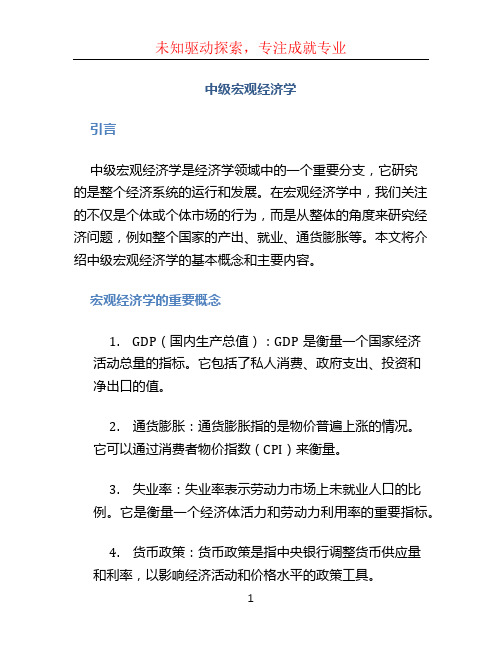
中级宏观经济学引言中级宏观经济学是经济学领域中的一个重要分支,它研究的是整个经济系统的运行和发展。
在宏观经济学中,我们关注的不仅是个体或个体市场的行为,而是从整体的角度来研究经济问题,例如整个国家的产出、就业、通货膨胀等。
本文将介绍中级宏观经济学的基本概念和主要内容。
宏观经济学的重要概念1.GDP(国内生产总值):GDP是衡量一个国家经济活动总量的指标。
它包括了私人消费、政府支出、投资和净出口的值。
2.通货膨胀:通货膨胀指的是物价普遍上涨的情况。
它可以通过消费者物价指数(CPI)来衡量。
3.失业率:失业率表示劳动力市场上未就业人口的比例。
它是衡量一个经济体活力和劳动力利用率的重要指标。
4.货币政策:货币政策是指中央银行调整货币供应量和利率,以影响经济活动和价格水平的政策工具。
中级宏观经济的主要内容经济增长理论经济增长理论是中级宏观经济学的核心内容之一。
它研究的是长期经济增长的原因和机制。
在经济增长理论中,我们常见的模型有新古典增长模型和克里斯蒂娜·罗默模型等。
新古典增长模型认为,技术进步、人力资本等因素是推动经济增长的主要驱动力。
它强调资本积累和技术进步对经济增长的重要性。
而克里斯蒂娜·罗默模型则强调创新和知识的重要性,认为技术进步是经济增长的主要来源。
货币与物价水平货币政策对经济增长和物价水平具有重要影响。
中级宏观经济学研究货币政策的工具、目标和影响机制。
货币政策工具包括调整基准利率、调整存款准备金率等。
通过控制货币供应量和利率,中央银行可以影响经济活动和价格水平。
物价水平的变化会对经济产生重要影响。
通货膨胀会导致物价上涨,对消费、投资和资金分配产生影响。
以往的货币超发和通货膨胀案例,如德国的魏玛共和国时期,给经济和社会带来了巨大的破坏。
失业与经济政策失业是一个严重的经济问题,中级宏观经济学研究失业的类型、原因和影响。
失业率的高低反映了一个经济体的劳动力利用率和经济活力。
经济政策对失业的影响也是宏观经济学关注的重点之一。
中级宏观经济学 ppt 课件 第7、8章

slide 11
▪ 假设生产函数“规模报酬不变”,也即
zY F( zK ,zL E) , z 0
CH 5 经济增长 Ⅱ
slide 12
密集形式的生产函数
▪ 符号说明:
y = Y/LE = 单位有效工人产出 k = K/LE = 单位有效工人资本存量
▪ 密集形式(单位有效工人)的生产函数:
y = f(k)
% of population living on $2 per day or less
100 Madagascar
90
India
80
Nepal
70
Bangladesh
60 Kenya
50
China
Botswana
40 30 20 10
0 $0
Peru Thailand
Mexico
Brazil Russian Chile Federation
经济增长理论
▪ 索洛模型
▪ 超越索洛模型:内生增长理论
CH 5 经济增长 Ⅱ
slide 10
索洛模型
▪ 生产函数:
YF(K,LE)
▪ E = 劳动效率, L E = 有效工人数量
▪ 假设:
技术进步是劳动扩展型,labor-augmenting:
能够以外生比率g 提高劳动效率:
g E E
CH 5 经济增长 Ⅱ
第7、8章 经济增长
CH 5 经济增长 Ⅱ
slide 0
本章主要内容
▪ 经济增长理论 ▪ 促进增长的政策 ▪ 经济增长的经验研究
CH 5 经济增长 Ⅱ
slide 1
经济增长的重要性
…对于贫穷国家
CH 5 经济增长 Ⅱ
中级宏观经济学(第8章)
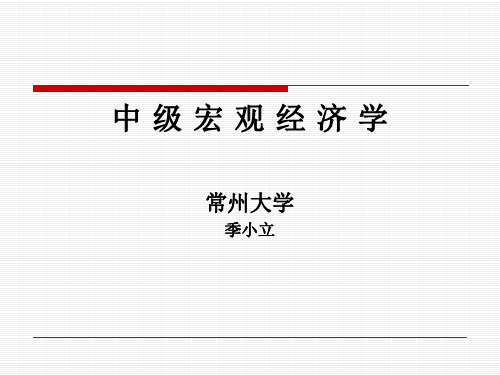
劳动需求曲线
企业所用劳动量(Q:人)
月工资水平(P:元)
系列1
200
400
600
800
1000
1200
企业所用劳动量Q/人
1000 800
? ? 200
3000 ?
5000 6000
?
劳动供给曲线
劳动市场供给量(Q:人)
理想月工资水平(P:元)
1000
7000
900
?
?
6000
系列1
700
?
?
5000
在这种情况下,如果其他条件不变,无论价格怎样提高,企业也 无法增加生产。
在这种情况下,总供给曲线是垂直的,又称古典情况。(书P244 图9-8)
第二节 短期总供给的形成
三、总供给曲线整体
书P244 图9-9 1、当物价为P0时,总供给曲线水平状,极端凯恩斯情况。 2、当物价在P0和P1之间时,总供给曲线向右上方倾斜,为一般情况。 3、当物价高于P1时,总供给曲线垂直状,称为古典情况。
第三节 短期总供给的变动
一、要素价格对总供给的影响 生产要素价格越高,使得企业的成本状况恶
化,从而一部分企业选择减少产量,导致总 供给减少。 书P245 图9-10
第三节 短期总供给的变动
二、资本存量对总供给的影响 资本存量增加,使劳动的边际产量增加,从
而使总供给增加,表现为总供给曲线向右边 平移。 书P245 图9-10
200
400
600
800
1000
1200
市场劳动供给量Q/人
500
?
?
4000
理想月工资水平P/元
参考答案
巴罗中级宏观弗吉尼亚第八章习题答案
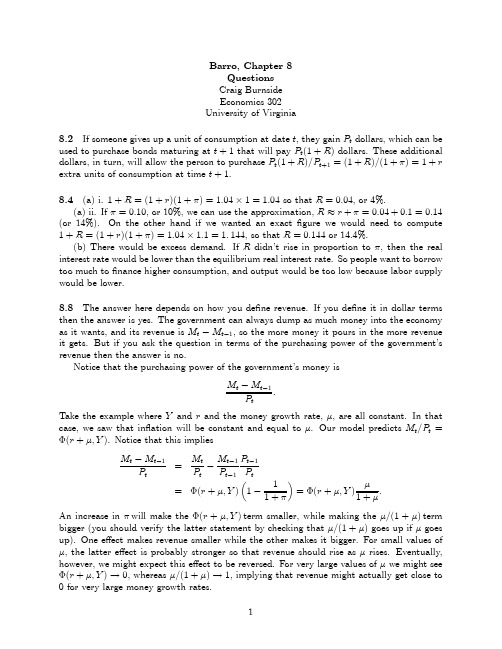
Barro,Chapter8QuestionsCraig BurnsideEconomics302University of Virginia8.2If someone gives up a unit of consumption at date t,they gain P t dollars,which can beused to purchase bonds maturing at t+1that will pay P t(1+R)dollars.These additionaldollars,in turn,will allow the person to purchase P t(1+R)/P t+1=(1+R)/(1+π)=1+rextra units of consumption at time t+1.8.4(a)i.1+R=(1+r)(1+π)=1.04×1=1.04so that R=0.04,or4%.(a)ii.Ifπ=0.10,or10%,we can use the approximation,R≈r+π=0.04+0.1=0.14(or14%).On the other hand if we wanted an exactfigure we would need to compute1+R=(1+r)(1+π)=1.04×1.1=1.144,so that R=0.144or14.4%.(b)There would be excess demand.If R didn’t rise in proportion toπ,then the realinterest rate would be lower than the equilibrium real interest rate.So people want to borrowtoo much tofinance higher consumption,and output would be too low because labor supplywould be lower.8.8The answer here depends on how you define revenue.If you define it in dollar termsthen the answer is yes.The government can always dump as much money into the economyas it wants,and its revenue is M t−M t−1,so the more money it pours in the more revenue it gets.But if you ask the question in terms of the purchasing power of the government’srevenue then the answer is no.Notice that the purchasing power of the government’s money isM t−M t−1P t.Take the example where Y and r and the money growth rate,µ,are all constant.In thatcase,we saw that inflation will be constant and equal toµ.Our model predicts M t/P t=Φ(r+µ,Y).Notice that this impliesM t−M t−1P t =M tP t−M t−1P t−1P t−1P t=Φ(r+µ,Y) 1−11+π =Φ(r+µ,Y)µ1+µ.An increase inπwill make theΦ(r+µ,Y)term smaller,while making theµ/(1+µ)term bigger(you should verify the latter statement by checking thatµ/(1+µ)goes up ifµgoes up).One effect makes revenue smaller while the other makes it bigger.For small values of µ,the latter effect is probably stronger so that revenue should rise asµrises.Eventually, however,we might expect this effect to be reversed.For very large values ofµwe might see Φ(r+µ,Y)→0,whereasµ/(1+µ)→1,implying that revenue might actually get close to 0for very large money growth rates.8.9(a)If you could hold goods between periods(i.e.they were not perishable)and their real value depreciated at the rateδbetween periods,then the“nominal interest rate”to holding them would be given by1+R G=P t+1(1−δ)P t=(1+π)(1−δ).So R G≈π−δ.The interest rate on bonds would still be R=r+π,so it seems unlikely that anyone would actually store the goods as long as R>R G,or r>−δ.The demand for money should still depend on R,and should remain unaffected as long as r>−δ.(b)Since R=r+πe,ifπe rises and R stays the same,r must be falling.If r fell so far that it became less than−δthen people would no longer hold bonds and would switch to storing goods as a way of saving.At that point,the demand for money would depend on the spread between the interest rate on storing goods,π−δ,and the interest rate on money,0. For this reason money demand would probably still fall becauseπe andπwould be rising.8.10(a)Real money demand isΦ(R,Y),so it falls if R rises.(b)People economize on money holdings by going to the bank more often.Therefore, they pay more transactions fees.(c)This implies a negative wealth effect,so C and leisure will fall and L rise.(d)Yes.Leisure also becomes relatively cheap because you don’t have to use money to purchase it.This means C will fall further,and the negative(positive)impact of the rise in R on leisure(labor supply)is mitigated by the substitution effect.8.13The House of Lords was right.By issuing the getting the bank note printers(Waterlow Co.)to deliver them fake notes the swindlers were able to use the fake notes to purchase real goods from the Portuguese economy.In a sense they were able to take some of what would otherwise have been the Portuguese government’s“tax”revenue and use it to purchase goods the Portuguese government could otherwise have acquired.Although printed money is not a claim to anything concrete,it has a value determined by people’s willingness to hold it.As a result,the swindlers were able to acquire goods by doing something only the Portuguese government was allowed to do:i.e.printing money.。
- 1、下载文档前请自行甄别文档内容的完整性,平台不提供额外的编辑、内容补充、找答案等附加服务。
- 2、"仅部分预览"的文档,不可在线预览部分如存在完整性等问题,可反馈申请退款(可完整预览的文档不适用该条件!)。
- 3、如文档侵犯您的权益,请联系客服反馈,我们会尽快为您处理(人工客服工作时间:9:00-18:30)。
Copyright © 2009 Pearson Education Canada
8-13
The Business Cycle Facts (continued)
Two important characteristics of the cyclical behaviour:
the direction in which a macroeconomic variable moves relative to the direction of aggregate economic activity; the timing of the variable’s turning points relative to the turning points of the business cycle.
Copyright © 2009 Pearson Education Canada 8-5
What is a Business Cycle?
1. Fluctuation of “aggregate economic activity”. 2. Expansions and contractions.
Copyright © 2009 Pearson Education Canada 8-15
The Business Cycle Facts (continued)
A leading variable’s turning points occur before those of the business cycle. A coincident variable’s turning points occur around the same time as those of the business cycle. A lagging variable’s turning points occur later than those of the business cycle.
In 1873-1914 there were almost as many months of contraction as months of expansion. In 1945-2001 the number of months of expansion outnumbered the month of contraction by more than five to one.
Copyright © 2009 Pearson Education Canada
8-2
Introduction to Business Cycles (continued)
The two basic questions are:
What causes business cycles? How policymakers should respond to cyclical fluctuations?
Prices, productivity, investment, and unemployment have regular patterns of behaviour.
Copyright © 2009 Pearson Education Canada
8-7
What is a Business Cycle? (continued)
Copyright © 2009 Pearson Education Canada
8-3
Introduction to Business Cycles (continued)
Classical economists view business cycles as representing the economy’s best response to disturbances in production and spending.
4. Recurrent but not periodic.
It does not occur at regular, predictable intervals and does not last for fixed, predetermined length of time.
5. Persistence.
Copyright © 2009 Pearson Education Canada
Expenditure
Consumption and fixed investment expenditures are procyclical and coincident. Inventory investment is procyclical, leading, and strongly volatile.
Copyright © 2009 Pearson Education Canada 8-16
Production
Production is a coincident and procyclical variable. Industries that produce more durable goods or capital goods are more sensitive to the business cycle than the industries producing nondurable goods.
Copyright © 2009 Pearson Education Canada 8-14
The Business Cycle Facts (continued)
A procyclical variable moves in the same direction as aggregate economic activity. A countercyclical variable moves in the opposite direction to aggregate economic activity. An acyclical variable does not display a clear pattern over the business cycle.
Copyright © 2009 Pearson Education Canada
8-10
Have Business Cycles Become Less Severe?
Real GDP growth and the unemployment rate are measured to be less volatile after 1945. The volatility may look lower due to poor quality of pre-1929 data. Further studies seem to confirm that cycles have been significantly moderated in the postwar period.
Copyright © 2009 Pearson Education Canada
8-19
Expenditure (continued)
Import expenditures are procyclical and coincident. Export expenditures are a reflection of foreign business cycles, not Canada’s. Business cycles are often transmitted between countries through the trade balance.
Copyright © 2009 Pearson Education Canada 8-9
The Canadian Business Cycle (continued)
The worst economic contraction in the history of Canada was the Great Depression of the 1930s. Strong economic recoveries are associated with World War I and World War II.
Copyright © 2009 Pearson Education Canada
8-4
Introduction to Business Cycles (continued)
Keynesian economists argue that because wages and prices adjust slowly, disturbances in production and spending may drive the economy away from its most desirable level of output and employment for long periods of time.
Chapter 8
Business Cycles
Copyright © 2009 Pearson Education Canada
Introduction to Business Cycles
The business cycle is a central concern in macroeconomics, because business cycle fluctuations are felt throughout the economy.
Copyright © 2009 Pearson Education Canada 8-11
Are Business Cycles Made in Canada?
The historical data show a strong coincidence between cycle turning points in Canada and the US. A study of business cycles in six major countries shows that a significant component of the business cycle does seem to be made in Canada.
